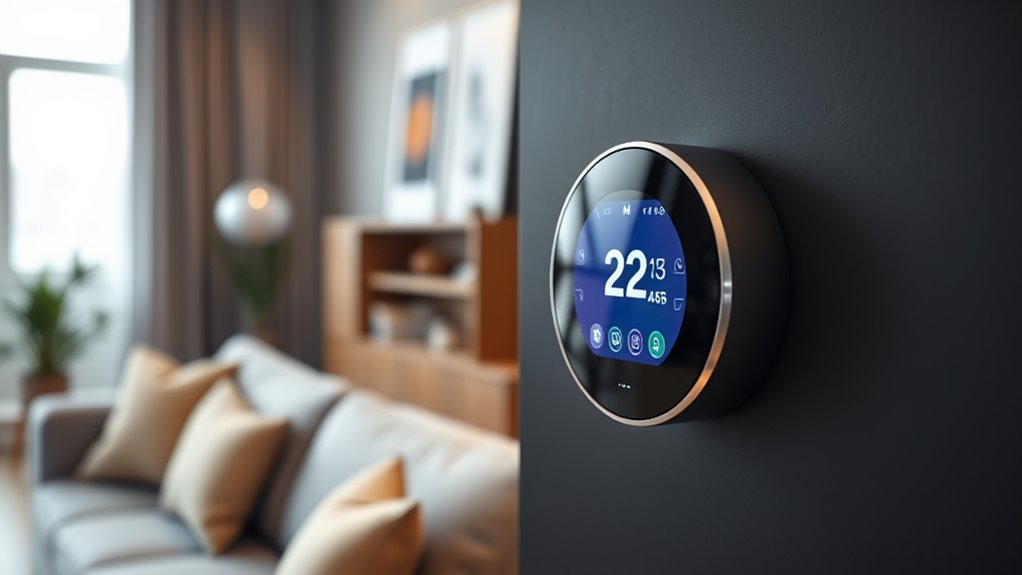Smart thermostats make saving energy simple by automatically adjusting your home’s temperature based on your habits and preferences. They learn your schedule, detect when you’re away, and optimize heating and cooling to reduce waste. You can control them remotely via smartphone and get insights on your energy use. With seamless integration into your smart home, they enhance comfort and efficiency effortlessly. Keep exploring how these devices can help you save more energy with minimal hassle.
Key Takeaways
- Smart thermostats optimize heating and cooling schedules automatically, reducing energy waste and lowering utility bills.
- Remote control apps allow easy adjustments, pre-heating or cooling your home before arrival for added convenience.
- Integration with sensors and other smart devices enables adaptive temperature settings based on occupancy and habits.
- Detailed energy reports help identify usage patterns and provide tips to further save energy.
- Advanced features and affordability make smart thermostats an effortless way to enhance home efficiency and sustainability.

Smart thermostats are transforming the way you control home temperatures by making energy management more efficient and convenient. With these devices, you can easily optimize your heating and cooling systems, leading to significant energy savings. Instead of manually adjusting your thermostat multiple times a day, a smart thermostat learns your schedule and preferences, automatically adjusting settings to keep your home comfortable while reducing unnecessary energy use. This means you’re not wasting energy when you’re away or asleep, which directly translates into lower utility bills and a smaller carbon footprint.
One of the biggest advantages of smart thermostats is user convenience. You gain the ability to control your home’s temperature remotely through a smartphone app, so you can turn up the heat before you arrive home or cool down the house if the weather suddenly warms up. The intuitive interfaces make it easy to set schedules, monitor energy consumption, and receive alerts about maintenance needs or potential issues. This level of control means you don’t have to manually adjust physical thermostats constantly, saving you time and effort.
Smart thermostats also integrate seamlessly with other smart home devices, creating a connected ecosystem that enhances your overall living experience. For example, they can work with smart sensors to detect when rooms are unoccupied and adjust temperatures accordingly. Some models even learn your habits over time, automatically tweaking settings for maximum efficiency without you having to intervene. This intelligent automation not only improves energy savings but also ensures your home stays comfortable at all times. Additionally, many smart thermostats use filtration systems to maintain indoor air quality, further contributing to a healthier living environment. Incorporating energy efficiency principles can help maximize the benefits of your smart thermostat and reduce overall energy consumption.
Furthermore, many smart thermostats provide detailed energy usage reports, helping you better understand how your habits impact your energy bills. Armed with this information, you can make informed decisions to further optimize your energy consumption. Some devices even offer tips for reducing energy waste, empowering you to take proactive steps toward a greener lifestyle. As technology advances, these devices are becoming more affordable and easier to install, making smart home energy management accessible to everyone. Additionally, smart home integration allows your thermostat to work in harmony with other systems, maximizing efficiency and comfort. With all these features, smart thermostats make energy management straightforward and hassle-free, ultimately making your home smarter and more sustainable.
Frequently Asked Questions
How Do Smart Thermostats Impact Home Insurance Rates?
You might wonder how smart thermostats impact your home insurance rates. They can lead to insurance discounts by helping with risk mitigation, such as preventing fires or water damage through better temperature control. Insurance companies see these devices as reducing potential claims, so you could save money on premiums. Installing smart thermostats shows you’re proactive in protecting your home, which insurance providers value when evaluating your risk level.
Are Smart Thermostats Compatible With All HVAC Systems?
Think of your HVAC system as a puzzle, and thermostat integration as the missing piece. Not all smart thermostats fit seamlessly, as HVAC compatibility varies. Before buying, check if your system supports smart technology or if you’ll need an adapter. Some systems, especially older ones, might require professional installation or upgrades. Ensuring compatibility guarantees smooth operation and maximizes the energy-saving benefits of your smart thermostat.
What Is the Average Cost of Installing a Smart Thermostat?
You’re curious about the average cost of installing a smart thermostat. Installation costs can vary depending on your home’s setup and the brand you choose. On average, you might spend between $100 and $250, but price variations do exist based on complexity and labor. To get an accurate estimate, consider consulting a professional, especially if your HVAC system requires special wiring or upgrades.
How Secure Are Smart Thermostats From Hacking Threats?
Think of your smart thermostat as a castle with digital guards. While it’s designed with cybersecurity risks and privacy concerns in mind, no system is completely invulnerable. Manufacturers continually update security features, but you should still use strong passwords and enable two-factor authentication. Staying vigilant helps protect your data, making your smart device more like a fortress than an open gate—secure but always watchful.
Can Smart Thermostats Function During Power Outages?
During a power outage, your smart thermostat’s power outage functionality depends on its backup power options. Many models include batteries or backup systems that allow you to maintain basic controls temporarily. However, if you don’t have these backup power options, the thermostat will stop functioning until power is restored. To guarantee continuous operation, consider installing a backup power source, like a battery or generator, for reliable power outage functionality.
Conclusion
So, here you are, saving energy effortlessly with smart thermostats—who knew that tiny devices could do so much? Ironically, while you enjoy lower bills and a greener planet, it’s almost amusing how simple technology has made us feel like energy-saving superheroes. Maybe the real power isn’t in the gadgets, but in how easily they slip into your daily routine, quietly proving that sometimes, the easiest solution really is the smartest.









